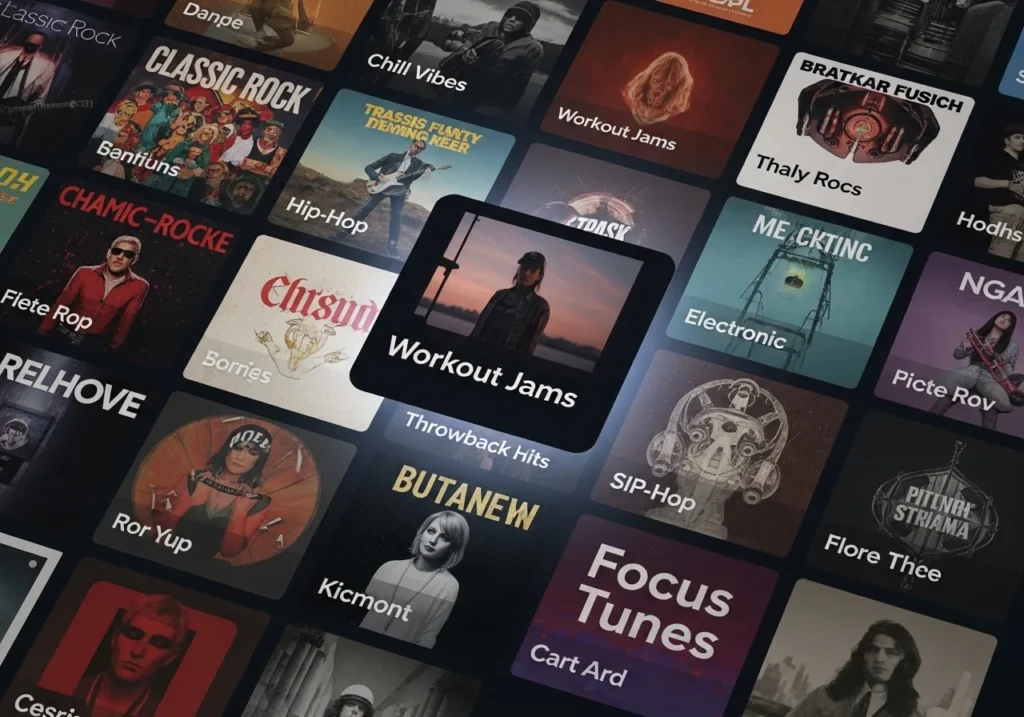Table of Contents
Introduction
The most powerful A&R executives in the world don’t have ears; they have code. These executives are the algorithmic playlists, the silent curators that now dictate the soundtrack of our lives. Far from being simple recommendation engines, they are active architects of culture, shaping our listening habits with a precision and influence that dwarfs the radio DJs and MTV VJs of the past. They operate on a simple, yet ruthless, logic of data, turning user engagement into a powerful feedback loop that can launch an unknown artist into global stardom or leave a creative genius languishing in obscurity. This is the new reality of the music industry: a world where success is increasingly determined not by human taste, but by the cold calculations of the hit-making algorithm.
This article dissects the hidden mechanics of this new musical world order. We will begin by deconstructing the machine itself, revealing how your skips, saves, and replays are translated into the fuel that powers these powerful algorithmic playlists. From there, we will explore one of the most significant consequences of the algorithmic playlists: the homogenization of sound. We will analyze how the system’s preference for “safe” sonic characteristics pressures artists to conform, potentially flattening the creative landscape and rewarding data-friendly music over genuine innovation. This investigation is crucial to understanding not just what we listen to, but why we listen to it.
Furthermore, we will examine the immense power these platforms wield, positioning them as the new, opaque gatekeepers of the industry and forcing a rethinking of the algorithmic playlists’ role. We will delve into the strategies artists and marketers employ to game the system, from legitimate tactics to the murky world of digital payola. Finally, we will look to the future, exploring the critical tension between machine efficiency and human curation. This journey will expose the five hidden ways these systems are quietly recomposing the very fabric of modern pop, forcing us to confront the profound cultural impact of our new robot overlords.

The Birth of the Bot: Deconstructing the Hit-Making Algorithm
Not long ago, the path to musical discovery was paved by human hands. DJs, A&R scouts, and critics were the gatekeepers, curating our tastes through a mix of expertise, intuition, and industry influence. The arrival of streaming promised a revolution—a supposed democratization of music where anyone could find an audience. This idealistic vision quickly gave way to a new, more opaque form of curation: the era of algorithmic playlists. These systems weren’t built on taste but on data, shifting the focus from expert opinion to the cold, hard numbers of user engagement. The initial promise was powerful, yet it laid the groundwork for a machine that would soon become the most influential gatekeeper of all.
The engine driving these powerful algorithmic playlists runs on a simple, yet potent, fuel: your listening habits. Every time you save a track, finish a song, or, most crucially, hit the skip button, you are feeding the machine critical data. Metrics like skip rate and completion rate are the primary signals that tell the algorithm whether a song is a hit or a miss. A low skip rate suggests listeners are captivated, while a high number of saves to personal libraries acts as a powerful endorsement. This constant stream of user behavior is meticulously analyzed, creating a feedback loop where the most engaging tracks are pushed to even larger algorithmic playlists, accelerating their journey from obscurity to ubiquity.
This data-driven process is the core function of the modern hit-making algorithm. Platforms like Spotify don’t just host music; they actively sift through millions of new tracks, searching for the ones with the highest potential for virality. When a song starts gaining traction on smaller playlists and demonstrates strong engagement metrics, the platform’s flagship algorithmic playlists—like Discover Weekly or RapCaviar—take notice. A placement here can be transformative, launching an unknown artist into the mainstream overnight. The consequences of the algorithmic playlists are clear: they have become the industry’s new star-makers, operating with a speed and scale that traditional methods could never match.

The Birth of the Bot: Deconstructing the Hit-Making Algorithm
Not long ago, the path to musical discovery was paved by human hands. DJs, A&R scouts, and critics were the gatekeepers, curating our tastes through a mix of expertise, intuition, and industry influence. The arrival of streaming promised a revolution—a supposed democratization of music where anyone could find an audience. This idealistic vision quickly gave way to a new, more opaque form of curation: the era of algorithmic playlists. These systems weren’t built on taste but on data, shifting the focus from expert opinion to the cold, hard numbers of user engagement. The initial promise was powerful, yet it laid the groundwork for a machine that would soon become the most influential gatekeeper of all.
The engine driving these powerful algorithmic playlists runs on a simple, yet potent, fuel: your listening habits. Every time you save a track, finish a song, or, most crucially, hit the skip button, you are feeding the machine critical data. Metrics like skip rate and completion rate are the primary signals that tell the algorithm whether a song is a hit or a miss. A low skip rate suggests listeners are captivated, while a high number of saves to personal libraries acts as a powerful endorsement. This constant stream of user behavior is meticulously analyzed, creating a feedback loop where the most engaging tracks are pushed to even larger algorithmic playlists, accelerating their journey from obscurity to ubiquity.
This data-driven process is the core function of the modern hit-making algorithm. Platforms like Spotify don’t just host music; they actively sift through millions of new tracks, searching for the ones with the highest potential for virality. When a song starts gaining traction on smaller playlists and demonstrates strong engagement metrics, the platform’s flagship algorithmic playlists—like Discover Weekly or RapCaviar—take notice. A placement here can be transformative, launching an unknown artist into the mainstream overnight. The consequences of the algorithmic playlists are clear: they have become the industry’s new star-makers, operating with a speed and scale that traditional methods could never match.

The Homogenization of Sound: How Algorithmic Playlists Flatten Creativity
While algorithmic playlists promise endless variety, they often achieve the opposite. Their logic is ruthlessly efficient: identify what works and promote more of it. This creates a sonic feedback loop where certain characteristics are heavily favored. Songs with short, hook-laden intros, predictable pop structures, and mid-tempo, unobtrusive beats are consistently rewarded because they are less likely to be skipped. The algorithm learns that these “safe” choices keep listeners engaged, and as a result, the flawed algorithmic playlists begin to curate a sound that is optimized for passive consumption, not active discovery. The inevitable consequence is a subtle yet pervasive flattening of musical creativity.
This pressure to conform is now a tangible force in the recording studio. Artists and producers are increasingly transparent about “writing for the algorithm,” a practice that prioritizes data-friendly elements over artistic intuition. The three-minute pop song is shrinking, intros are vanishing, and experimental song structures are often sanded down to fit the mold. This new reality forces a difficult choice upon creators: do they take an artistic risk that might be punished by the machine, or do they craft a track engineered to please the algorithmic playlists? The fear of being algorithmically ignored is a powerful motivator, potentially stifling the very innovation that drives music forward.
The result is a more monolithic pop landscape. As algorithmic playlists blend genres to match moods and activities rather than artistic intent, distinct sonic boundaries begin to dissolve into a single, homogenous stream. While this can create seamless listening experiences, it also risks eroding the unique textures and cultural contexts that make different genres vibrant. The consequences of the algorithmic playlists are not just about which songs become hits, but about what kind of music gets made in the first place. We are witnessing the rise of a new musical monoculture, quietly composed by code.

The New Gatekeepers: Rethinking the Algorithmic Playlists as Industry Power
The music industry’s traditional gatekeepers—the radio DJs who broke new bands, the A&R scouts who signed them—have been quietly usurped by a new, more powerful entity. Today, a coveted spot on a high-traffic algorithmic playlist is the modern equivalent of heavy radio rotation. This fundamental shift transfers immense curatorial power from human tastemakers to opaque lines of code. The algorithmic playlists have become the new arbiters of success, replacing gut feelings and industry relationships with a system driven entirely by engagement metrics. An artist’s breakthrough moment is no longer orchestrated in a boardroom but coded into a server.
This new form of gatekeeping directly fuels the streaming economy. A successful run on a major algorithmic playlist can generate millions of streams in a matter of weeks, translating into significant royalty revenue and, more importantly, tangible career momentum. This sudden surge in visibility attracts the attention of record labels, booking agents, and brand partners, turning a fleeting digital moment into a sustainable career path. In this ecosystem, the algorithmic playlists are not merely recommending songs; they are actively shaping the financial destinies of artists, deciding who gets the opportunity to build a livelihood from their craft.
Yet, for all their influence, these systems operate as a “black box.” The exact logic that governs the algorithmic playlists is a closely guarded corporate secret, raising critical questions about transparency and fairness. Are these algorithms truly meritocratic, or do they contain hidden biases that favor certain genres, artist profiles, or major-label partnerships? This lack of clarity makes a critical rethinking the algorithmic playlists’ role essential. As the new arbiters of fame and fortune, their unaccountable power demands far greater scrutiny from creators and listeners alike.

Gaming the System: The Strategies Behind a Successful Playlisting Strategy
In an environment governed by code, artists and their teams are no longer just making music; they are developing sophisticated strategies to capture the attention of the machine. A successful playlisting strategy is now as crucial as the marketing plan for a new album. The core objective is to signal to the algorithmic playlists that a new track has organic momentum. This involves a coordinated effort, often starting weeks before a song is even released, designed to create a data trail so compelling that the platform’s most powerful promotional tools are forced to take notice and amplify the track to a global audience.
The most effective tactics focus on generating a powerful burst of engagement on release day. Pre-save campaigns, which encourage fans to save a song to their library before it’s out, are a popular tool for ensuring a surge of initial streams. This early data is critical. The strategy often involves targeting smaller, influential user-curated playlists first. Securing placements on these lists creates a “trigger city” effect, where a song proves its appeal with a niche audience. This positive performance—high saves, low skips—is precisely the kind of data the larger, more powerful algorithmic playlists are designed to detect and reward with wider exposure.
However, where there is a system, there are those who will try to exploit it. The pressure to succeed has given rise to a murky underworld of playlisting services. This ranges from a gray area of “pay-for-play,” where artists pay for guaranteed placements on third-party playlists, to the outright fraud of streaming farms that use bots to generate fake streams. These tactics are designed to trick the algorithm into recognizing false momentum, polluting the data that feeds the algorithmic playlists. This darker side not only violates platform terms but also undermines the entire system, making it harder for genuine, organically-growing artists to be discovered.

The Human vs. The Machine: The Future Outlook for Algorithmic Playlists
As the reign of algorithmic playlists continues, a quiet counter-movement is gaining ground, one that champions the irreplaceable value of human curation. While algorithms excel at identifying patterns and predicting listener behavior, they lack the cultural context, emotional intuition, and narrative flair of a human tastemaker. Listeners are beginning to feel the limitations of a purely data-driven experience, sensing the missing element of surprise and genuine discovery. This has led to a renewed appreciation for hand-picked selections, creating a push-and-pull between the machine’s efficiency and the human’s ability to tell a story through music.
The future of music discovery will likely involve a deeper synthesis of these two forces. Emerging technologies are pushing the boundaries of what algorithmic playlists can do, moving toward a model of hyper-personalization where playlists are curated not just for a mood, but for an individual’s specific context in real-time. Imagine AI-driven systems that adjust a playlist based on your location, the weather, or even your heart rate. While this offers unprecedented customization, it also risks creating even tighter feedback loops, further insulating us from sounds that might challenge our tastes. The evolution of the algorithmic playlists is inevitable, but their direction is not yet set.
This brings us to the most critical questions about the long-term cultural impact of these systems. What is the cost of outsourcing our discovery to lines of code? When we optimize for engagement, what artistic qualities do we devalue? Rethinking the algorithmic playlists is not about abandoning the technology, but about demanding a more transparent and balanced model. A healthier future for music culture requires a symbiotic relationship where algorithms serve as powerful tools to augment, not replace, the essential human element of curation. We must decide if we want a future soundtracked by perfect, predictable data or one that still leaves room for beautiful, human imperfection.

Conclusion
We have seen that the rise of algorithmic playlists represents the most significant shift in music discovery in a generation. These systems, built on a foundation of user data, have become the new industry gatekeepers, replacing human intuition with the cold, impartial logic of code. By translating listener behavior—our skips, saves, and shares—into a powerful curatorial force, platforms now possess the ability to manufacture hits on a global scale. The once-clear path to stardom, traditionally navigated with the help of A&R scouts and radio programmers, has been rerouted through a complex, data-driven machine that operates largely outside of public view.
The consequences of this new paradigm are profound and far-reaching. As we’ve explored, the relentless optimization for engagement has led to a subtle homogenization of sound, rewarding music that is algorithmically “safe” over that which is artistically daring. This pressure to conform has fundamentally altered the creative process for many artists, while the opaque nature of the algorithmic playlists raises critical questions about fairness, bias, and corporate accountability. The strategies employed to “game” the system, from savvy marketing to outright fraud, further highlight the high stakes in a world where a single playlist placement can define a career.
Ultimately, the invisible hand of the algorithmic playlists is not just curating our present; it is actively composing the future of music itself. The purpose of exposing these hidden mechanics is not to reject the technology, but to demand a more conscious and transparent relationship with it. As musicians, marketers, and listeners, we must advocate for a healthier ecosystem—one that balances the power of the algorithm with the invaluable nuance of human curation. The future of a diverse, vibrant, and innovative musical culture depends not on blindly trusting the machine, but on critically questioning the code that shapes our world.







